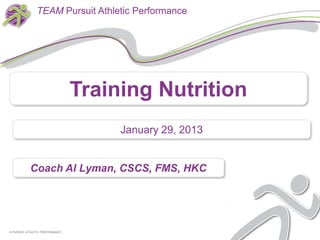
Training nutrition
- 1. TEAM Pursuit Athletic Performance Training Nutrition January 29, 2013 Coach Al Lyman, CSCS, FMS, HKC © PURSUIT ATHLETIC PERFORMANCE
- 2. TEAM Pursuit Athletic Performance Our Goals For This Evening: •Accessing FFAs As A Fuel: The “Secret” To Endurance? •Definition of endurance •What is our goal? •How do we access EFAs during exercise? •Fueling and Periodization •Off-season / pre-season / in-season philosophies •Off season guidelines for you! •Strategies For Optimizing Endurance and Body Composition •Daily eating strategies •Post training fueling •Nighttime eating •General guidelines for daily consumption of calories and carbohydrate •Common pitfalls of many endurance athletes •Fueling During Training •General guidelines © PURSUIT ATHLETIC PERFORMANCE
- 3. TEAM Pursuit Athletic Performance Accessing FFAs as a Primary Source of Fuel What is your definition of endurance? What is our goal in refining our strategy? The Big Question: How do we access FFAs during exercise? (next slide) © PURSUIT ATHLETIC PERFORMANCE
- 4. TEAM Pursuit Athletic Performance Fat Burning: What’s It All About? How do we access FFAs during exercise? Meal timing: a“magic” 3 hour window prior to training – prior to sleeping Glycemic Index Adequate daily fat consumption, especially “good” fats “Gas tank” analogy Train with a “full” tank Maintain optimal/normal insulin levels Stave off depletion of stored glycogen Recovery and adaptation to training! © PURSUIT ATHLETIC PERFORMANCE
- 5. TEAM Pursuit Athletic Performance Fueling and Periodization: Philosophy Let’s “periodize” our eating and fueling as we do our training Develop a different strategy depending upon the time of year and the focus of training © PURSUIT ATHLETIC PERFORMANCE
- 6. TEAM Pursuit Athletic Performance Fueling and Periodization What is our OFF-season philosophy? As a general rule, no fueling during training Exceptions to the “rule”?: “Long” training day prior to a “quality” training day When you’re not eating as you ought to be © PURSUIT ATHLETIC PERFORMANCE
- 7. TEAM Pursuit Athletic Performance Guidelines For The Off-Season Do not eat or fuel prior to morning training sessions Progress this “skill” (your ability to burn fat as a fuel) progressively over time… Begin by not fueling for any session lasting up to 90minutes Progress up to 3 hours Beyond 3 hours, fueling is an option Always CARRY fuel with you, in case you need it for any reason (bonking!) Make your routine choices “clean” and whole food based when possible © PURSUIT ATHLETIC PERFORMANCE
- 8. TEAM Pursuit Athletic Performance Fueling and Periodization What is our PRE-season philosophy? Start to transition to occasional “practice” for in-season fueling strategies Consider cumulative effect of increasing training loads, as a factor in determining choice to fuel, or not Find out what works for you! Develop a strategy to… Optimize body composition Daily energy levels Overall adaptation to training © PURSUIT ATHLETIC PERFORMANCE
- 9. TEAM Pursuit Athletic Performance Fueling and Periodization What is our IN-season philosophy? Use race-specific training sessions to “practice” and refine your fueling strategy Every training session provides an opportunity to experiment and “practice” During longer and/or “race-specific” training, fuel as you plan to on race day Other than those specific sessions, take care to routine fuel well and appropriately, to support your recovery and adaptation to training © PURSUIT ATHLETIC PERFORMANCE
- 10. TEAM Pursuit Athletic Performance Important Daily Strategies Taper calorie intake King/Queen/Pauper Taper carbohydrate intake Biggest carbohydrate “meal” should be the one right after your most important or longest training session of the day After training re-fueling is KING 30minute window: glycogen synthase Carbs (60-70%) > protein (10-20%) > fat Avoid eating 3 hours prior to going to sleep © PURSUIT ATHLETIC PERFORMANCE
- 11. 16-23 calories per pound of body weight per day 1 hr daily training at 70% VO2 max: 2.5 -3 grams carbohydrate (CHO) per pound of body weight per day, 2 hours daily training at 70% VO2 max or above: 3.5 -4.5 grams CHO per pound body weight per day. How many calories and how much carbohydrate should a 132 pound female triathlete who trains 1 hour daily at 70% VO2 max consume? Step 1: Determine the estimated calorie intake by multiplying 20 calories per pound by 132 pounds. Using the middle range of the estimate, this athlete needs approximately 2,520 daily calories. 20 cal X 132 pounds = 2,640 cal/day Step 2: Determine the estimated carbohydrate (CHO) intake by multiplying 3.5 grams of CHO by 132 pds. Using the lower end of the estimate, this athlete needs approx. 360 grams of CHO daily. 3 g. CHO X 132 pounds = 396 g CHO/day Determination: A 132-pound female distance swimmer who trains 1 hour daily at 70% VO2 max should consume at least 2,640 calories and 396 g carbohydrate daily.
- 12. TEAM Pursuit Athletic Performance Common Pitfalls of Endurance Athletes: Inadequate calories (and/or not the optimal makeup of calories) in the “after” training time period Day-time fasting to lose “weight” Often leads to late night binging, aka “back loaded” daily eating, poor adaptation to training, low energy, higher body fat % Constant snacking to “ensure” adequate energy levels for training (which often ends up having the reverse effect of lowering energy) Too much simple sugar or processed foods in the diet, at the wrong times of day Inadequate “good fats” consumption Inadequate quality protein consumption © PURSUIT ATHLETIC PERFORMANCE
- 13. TEAM Pursuit Athletic Performance Fueling During Training 200 calories per hour +/- Depending on intensity, body size, gastric emptying Intensity and fueling: an inverse relationship Liquid vs. solid Absorption rate Like an “IV”: small amounts more frequently Less is more Dilute! Water is an aid to digestion in addition to facilitate hydration Be flexible with your planned strategy OODA loop Simple better than complex Less is more © PURSUIT ATHLETIC PERFORMANCE